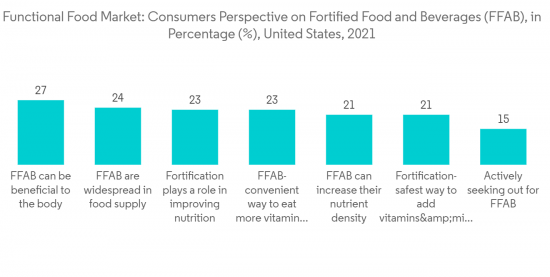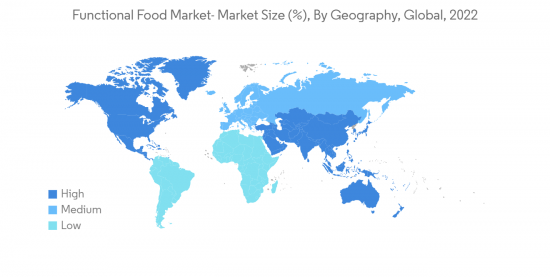PUBLISHER: Mordor Intelligence | PRODUCT CODE: 1333669

PUBLISHER: Mordor Intelligence | PRODUCT CODE: 1333669
Functional Food Market Size & Share Analysis - Growth Trends & Forecasts (2023 - 2028)
The Global Functional Food Market size is expected to grow from USD 186.22 billion in 2023 to USD 212.85 billion by 2028, at a CAGR of 2.71% during the forecast period (2023-2028).
Functional foods offer specific health benefits that are beyond the regular daily intake of nutrients, such as improved bone health, cholesterol management, improved heart health, and other benefits associated with eye health and vision. The increasing demand for nutritional and fortifying food additives is anticipated to drive market growth. Food manufacturers are deploying the fortification of nutritional additives, such as omega-3 fatty acids, fiber, vitamins, and minerals, in their product offerings. The intention of incorporating the aforementioned additives in the food industry is to increase the nutritional content of food items.
Functional food in sports nutrition has emerged as the largest segment due to the increasing commercialization of sports nutrients and the availability of a wide product range, including creatine and whey protein-based functional food. In January 2021, Danone North America launched a new plant-based protein beverage aimed at athletes. Silk Ultra is a multi-serve, dairy-free beverage with 20 grams of soy protein per serving, designed for muscle maintenance and repair. The drink is enriched with calcium and vitamins A, D, B2, and B12 and comes in three flavors: creamy chocolate, unsweet, and original, which, according to the company, includes 2.5 times the protein of typical dairy milk.
Functional Food Market Trends
Increasing Consumption of Nutrient-Enriched Food
- Consumers' understanding of the impact of nutrition on physical and mental well-being has enhanced over the years. The awareness regarding the health benefits of functional foods in protecting against diseases such as cancer, heart disease, diabetes, etc., is rising. Therefore, the positive impact of functional foods on one's health is supporting market demand and growth. The growing population and changes in food fashion among people are the major drivers for the market.
- Further, consumers are inclined toward foods containing functional ingredients to reduce the risk of certain health conditions, such as obesity, weight management, diabetes, and cardiovascular diseases. The hectic lifestyles and increasing stress have contributed to the increasing prevalence of such health disorders. Moreover, in general, people tend to consume big meals three to four times a day. This has created a negative impact on people's health. The growing awareness and shift in eating habits have led to a trend of eating multiple smaller meals during the day.
- These factors have boosted healthy foods and replaced meals with nutritional biscuits, snacks, and energy or protein bars. Also, the growing trend of on-the-go snacking is becoming extremely popular among children, owing to their need for regular meals. At the same time, adults prefer them due to their active hectic lifestyles. In addition, healthy snacking options, like energy bars, form affordable and convenient solutions for people and help keep their weight checked and regulated.
- For instance, in March 2022, Clif Bar & Company launched 'Think Snack Bars', expanding its on-the-go snacking segment for consumers. The product is made with plant-based ingredients to support health and offers snacking options with flavor and real ingredients like organic rolled oats.
- In July 2021, Clif Bar & Company introduced nut butter-filled energy bars into the Australian market via its exclusive distributor Unique Health Products. These bars were launched in three flavors: peanut butter, chocolate peanut butter, and chocolate hazelnut butter, and have been certified organic, containing 12% nut and pea protein, and free from artificial flavors and synthetic preservatives.
- Individuals are more concerned about their health and willing to pay extra for food specifically beneficial to their health. Protein is becoming a priority for consumers worldwide as it is considered "anti-fat" and "anti-sugar" and a high source of instant energy. Thus, consumers are increasingly seeking protein ingredients in food products termed nutrient-enriched food, which is expected to positively impact the growth of the functional food market.

Asia-Pacific Dominates the Market
- Asia-Pacific is the major market for functional food products. Increasing consumer interest, and a better understanding of the immunity-enhancing property of proper diet and food habits, are some of the key factors driving the growth of vitamin-fortified and mineral-enriched food and beverage product sales.
- Moreover, in countries such as Japan and China, manufacturers are becoming more creative with dairy packaging, ingredients, and flavors, introducing fortified variants easily, thus boosting the functional food market.
- Yogurt, owing to its multifunctional attributes, holds great prominence among consumers. With a growing share of consumers avoiding certain food ingredients or attributes for health and fitness purposes, ingredient and nutrition labels are becoming major information sources for purchase decisions.
- Consequently, the awareness of food labeling is growing in Japan, as calorific values and fat contents are considered the most important information on nutrition fact labels. According to the Japanese Health And Beauty report, in 2021, 1145 products were registered as functional foods. For instance, in February 2021, Nestle Japan rolled out plant-based almond and oat milk lattes.
- Additionally, a large section of the Chinese population is lactose intolerant. Hence, consumers find plant-based yogurt a relatively better option due to its fermented nature, making it easily digestible. For instance, in May 2021, the Chinese plant-based snacking company, Marvelous Foods, launched Yeyo coconut yogurt on the e-commerce platform, Tmall. Yeyo is plant-based coconut yogurt with zero added sugar, artificial flavors, and sweeteners. The initial launch featured three stock-keeping units (SKUs), and the range includes a 'pure' sugar-free flavor, plus two yogurt-granola cups with seasonal fruit and nut granola topping for flavor and nutrition. Consumers are becoming increasingly interested in food and beverages that are less processed and have more natural and organic ingredients, as well as being environmentally friendly. Hence, all the above-mentioned factors positively drive the market in the region.

Functional Food Industry Overview
The functional food market is competitive, with many domestic and multinational players competing for market share. As their key marketing strategies, companies focus on new product launches with healthier ingredients/organic claims and acquisitions, mergers, partnerships, and expansions. Some of the major players in the market studied are Danone SA, Nestle S.A., PepsiCo Inc., Kellogg's Company, and Abbott Laboratories.
Key players are now focusing on social media platforms and online distribution channels for their products, online marketing, and branding to attract more customers. To attain a larger market share, manufacturers are revitalizing their product portfolios targeting health-conscious consumers.
Additional Benefits:
- The market estimate (ME) sheet in Excel format
- 3 months of analyst support
TABLE OF CONTENTS
1 INTRODUCTION
- 1.1 Study Assumptions and Market Definition
- 1.2 Scope of the Study
2 RESEARCH METHODOLOGY
3 EXECUTIVE SUMMARY
4 MARKET DYNAMICS
- 4.1 Market Drivers
- 4.2 Market Restraints
- 4.3 Porter's Five Forces Analysis
- 4.3.1 Bargaining Power of Suppliers
- 4.3.2 Bargaining Power of Consumers
- 4.3.3 Threat of New Entrants
- 4.3.4 Threat of Substitutes
- 4.3.5 Intensity of Competitive Rivalry
5 MARKET SEGMENTATION
- 5.1 Product Type
- 5.1.1 Bakery Products
- 5.1.2 Breakfast Cereals
- 5.1.3 Snack/Functional Bars
- 5.1.3.1 Sports Bars
- 5.1.3.2 Energy Bars
- 5.1.3.3 Protein Bars
- 5.1.4 Dairy Products
- 5.1.4.1 Yogurt
- 5.1.4.2 Other Functional Dairy Products
- 5.1.5 Baby Food
- 5.1.6 Other Product Types
- 5.2 Distribution Channel
- 5.2.1 Supermarkets/Hypermarkets
- 5.2.2 Specialist Retailers
- 5.2.3 Convenience/Grocery Stores
- 5.2.4 Online Retail Stores
- 5.2.5 Other Distribution Channels
- 5.3 Geography
- 5.3.1 North America
- 5.3.1.1 United States
- 5.3.1.2 Canada
- 5.3.1.3 Mexico
- 5.3.1.4 Rest of North America
- 5.3.2 Europe
- 5.3.2.1 United Kingdom
- 5.3.2.2 Germany
- 5.3.2.3 Spain
- 5.3.2.4 France
- 5.3.2.5 Italy
- 5.3.2.6 Russia
- 5.3.2.7 Rest of Europe
- 5.3.3 Asia-Pacific
- 5.3.3.1 China
- 5.3.3.2 India
- 5.3.3.3 Japan
- 5.3.3.4 Australia
- 5.3.3.5 Rest of Asia-Pacific
- 5.3.4 South America
- 5.3.4.1 Brazil
- 5.3.4.2 Argentina
- 5.3.4.3 Rest of South America
- 5.3.5 Middle East & Africa
- 5.3.5.1 South Africa
- 5.3.5.2 United Arab Emirates
- 5.3.5.3 Rest of Middle East & Africa
- 5.3.1 North America
6 COMPETITIVE LANDSCAPE
- 6.1 Most Adopted Strategies
- 6.2 Market Share Analysis
- 6.3 Company Profiles
- 6.3.1 Lotus Bakeries
- 6.3.2 Nestle S.A.
- 6.3.3 Hearthside Food Solutions LLC
- 6.3.4 Valio Eesti AS
- 6.3.5 The Kellogg's Company
- 6.3.6 Abbott Laboratories
- 6.3.7 PepsiCo Inc.
- 6.3.8 Danone SA
- 6.3.9 Clif Bar & Company
- 6.3.10 General Mills
- 6.3.11 Laird Superfoods
- 6.3.12 Cocos Organic
- 6.3.13 Yakult Honsha Co., Ltd.
- 6.3.14 Care Nutrition
- 6.3.15 Hindustan Unilever Ltd
7 MARKET OPPORTUNITIES AND FUTURE TRENDS




